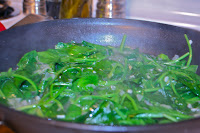
Indulging thoughts about food, nutrition, and agriculture. The combination of being a foodie, Registered Dietitian, and having a communications degree.
Monday, February 28, 2011
A Fine Piece of Meat!

Saturday, February 26, 2011
Newest Kitchen Tool: Boos Block


Wednesday, February 23, 2011
Snacks vs Meals

- Weight train to build lean muscle
- Sleep 7-8 hours a night (lower or higher has shown to increase appetite)
- Eat fruits, vegetables and whole grains
Friday, February 18, 2011
Variety is key!






Thursday, February 17, 2011
Community Garden for Greenville, NC

I am so excited to announce that I recently found out that Greenville was starting a Community Garden. It will be located near the Senior Center on County Home Road across from Wintergreen Elementary School. If you are like me and you live in an apartment this is a dream come true. I have been waiting for the day to start my own garden (in the ground, not just in pots) and this is now possible.
The program is ran through a Blue Cross Blue Shield grant and the hope is that it will become sustainable and last for years to come. I was able to sit down with the head of this initiative and hear some details.


Wednesday, February 9, 2011
Per Request: Stuffed Eggplant Recipe

1/2 large yellow onion
1/2 cup whole wheat couscous
1/2 cup of frozen peas
/2 cup plain tomato sauce
2 cloves of garlic
2 ounces of baby swiss cheese
1/4 cup of fresh grated parmesan
2 tablespoons of olive oil
salt and pepper to taste
Wednesday, February 2, 2011
February is HEART MONTH!!
- High Cholesterol
- Tobacco Use
- Lack of Physical Activity
- Poor Diet
- Stress
- Excessive Alcohol Consumption
THE NUMBERS:
Heart Disease andStroke Statistics—2011 Update: Summary
circ.ahajournals.org February 1, 2011
67.3% of adults who are 20 years of age or older are overweight and obese.
33.7% of USadults are obese (body mass index > 29.5 kg/m2). (Men/women/every race)
31.9% of children ages 2-19 are overweight and obese, and 16.3% are obese.
Over the past 3 decades, the prevalence of obesity in children 6 to 11 years of age has increased from 4% to more than 20%.
The prevalence of diabetes mellitus is increasing dramatically over time, in parallel with the increases in prevalence of overweight and obesity.
The proportion of youth less than 18 years of age who report engaging in no regular physical activity is high, and the proportion increases with age. In 2007, among adolescents in grades 9 through 12, 29.9% of girls and 17.0% of boys rep
orted that they had not engaged in 60 minutes of moderate-to-vigorous physical activity, defined as any activity that increased heart rate or breathing rate, even once in the previous 7 days, despite recommendations that children engage in such activity at least 5 days per week.
36% of adults reported engaging in no vigor- ous activity.
Data from NHANES indicate that between1971 and 2004, average total energy consumption among US adults increased by 22% in women (from 1,542 to 1,886 kcal/d) and by 10% in men (from 2,450 to 2,693 kcal/d).
PREVENTION IS KEY:
Limit foods with saturated fats, trans fat and high cholesterol
Increase DAILY physical activity to at least 60 minutes a day
Limit sedentary activities to less than 2 hours a day
Go for annual doctor's appointments and learn your numbers (HDL, LDL, TG, Weight, BMI)
Educate yourself and your family
RESOURCES:
There are many websites available which offer reliable information on heart disease. Please check out the links below. You can take an assessment that will measure your risks. I took it and it was less than 5 minutes. Here is a sample of what the assessment looks like.







